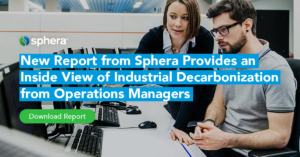
As calls for greater transparency in companies’ impact on climate change get louder, it’s clear that now is the time for companies to measure and reduce their carbon footprint. But getting a complete picture of a company’s greenhouse gas (GHG) emissions is no small feat. For many businesses, quantifying and reducing Scope 3 emissions—the indirect emissions that come from a company’s value chain, upstream and downstream—present a major challenge.
As Sean Daley, Sphera’s director of sustainability consulting, said in an episode of the SpheraNOW podcast, Scope 3 emissions can account for 60 to 99% of a company’s GHG emissions. Compared to Scope 1 and 2 emissions, which are the emissions that many companies report on, quantifying Scope 3 emissions constitutes a greater challenge because they stem from sources that aren’t in the direct control of the business.
Despite the complexity involved with measuring, reporting and reducing Scope 3 emissions, it’s never been more important to get a handle on them. Reducing Scope 3 emissions will be key to reaching net-zero emissions by 2050. Moreover, investors are increasingly taking a company’s environmental impact into consideration when making investment decisions.
This is, in part, fueling the increased regulatory pressure on companies to report their environmental impact, including Scope 3 emissions. For example, the European Union’s Corporate Sustainability Reporting Directive (CSRD) and the proposed climate-related disclosure rules from the U.S. Securities and Exchange Commission (SEC) require companies to report their Scope 3 emissions. To ensure compliance, make progress toward net zero and compete for investment dollars, companies will need to address Scope 3.
It’s important to consider which Scope 3 topics will be material to a business. Financial institutions, for example, should focus on reducing and reporting their portfolio emissions—referred to as “financed emissions”—which are the indirect Scope 3 emissions that stem from investing and lending activities. The SpheraCloud Corporate Sustainability – Portfolio Management solution helps financial institutions and corporations that make investments quantify and report financed emissions in line with Partnership for Carbon Accounting Financials (PCAF) and GHG Protocol standards.
For manufacturers, quantifying Scope 3 emissions has involved surveying suppliers and using economic input-output data. Given that some companies have thousands of suppliers, collecting data from them is a massive undertaking, and the data collected from them may not be of high quality. Additionally, economic input-output models rely on broad estimates and don’t paint an accurate picture of a company’s Scope 3 emissions. Sphera is actively working to get better Scope 3 information directly from the supply chain.
There are strategies and tools available that can help companies quantify Scope 3 emissions accurately and efficiently. For example, companies can perform life cycle assessments (LCAs) on their full product portfolios to get a more holistic view of product sustainability performance. Additionally, with the help of an LCA automation solution like Sphera’s, companies can perform LCAs at scale and in a fraction of the time and cost. This offers a faster, more efficient route to the information needed for Scope 3 disclosures. LCA automation also allows companies to identify emissions hotspots across thousands of products, driving progress toward meeting decarbonization goals.
As Daley outlined in the podcast, there are a number of ways to leverage LCAs to reduce Scope 3 emissions. LCAs can help companies better understand the climate impact of their products, including the type and amount of fuel used to manufacture them. Once companies have a clear picture of the amount of energy used to produce their products, they can make changes to reduce the amount of energy needed in that process.
LCAs can also help companies determine the impact of the raw materials they purchase, which can then help guide more sustainable purchasing decisions. Companies can also use this powerful tool to understand the emissions produced in the use and production phases of products, as well as determine the emissions that come from transportation, both upstream and downstream.
Large companies with complex supply chains need to strengthen their relationships with their supply chain partners—not only for the sake of Scope 3 emissions tracking and reporting, but also for compliance with regulations that examine a company’s procurement and use of materials and its treatment of its employees and supply chain workers. With regulations now looking more closely at various aspects of a company’s supply chain, we’re seeing many companies develop comprehensive sustainable procurement programs.
While Scope 3 emissions pose a challenge, the companies that take steps to address them now will be in a better position to attract investors, meet regulatory requirements and achieve net-zero goals. Armed with the right data, software and expertise, companies can solve the Scope 3 challenge.
–Paul
Learn more about Paul Marushka.
The ESG Shift: LCA Automation Is Now Business Critical


